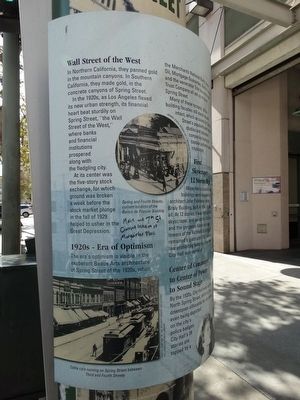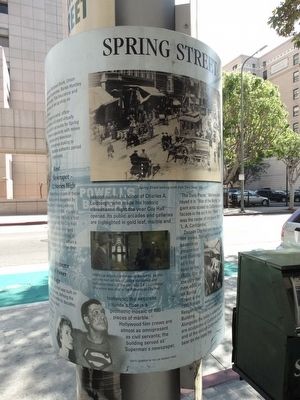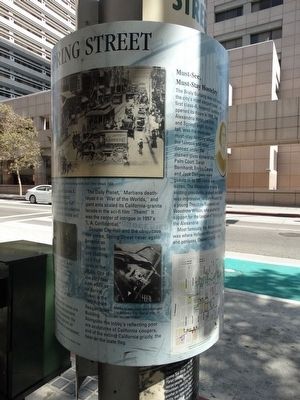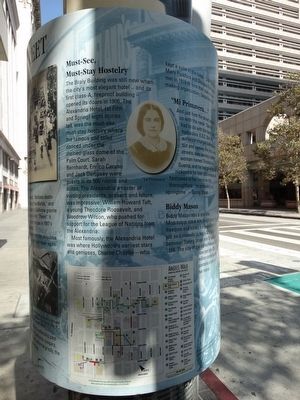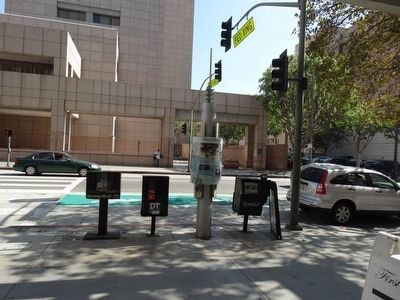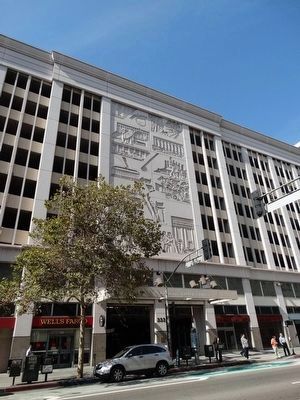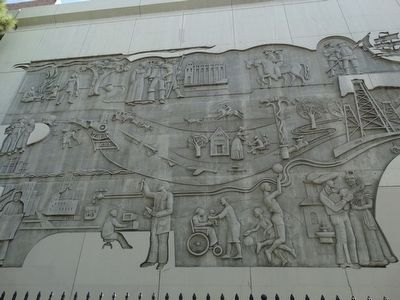Downtown Los Angeles in Los Angeles County, California — The American West (Pacific Coastal)
Spring Street
Wall Street of the West
In Northern California, they panned gold in the mountain canyons. In Southern California, they made gold, in the concrete canyons of Spring Street.
1920’s – Era of Optimism
The era’s optimism is visible in the exuberant Beaux Arts architecture of Spring Street of the 1920’s, when the Merchants National Bank, Union Oil, Mortgage Guarantee, Banks Huntley and the venerable Title Insurance and Trust Company all set up shop on Spring Street.
Many of these tycoons’ office buildings facades still stand virtually intact, which accounts for Spring Street’s popularity with movie studios and television companies looking to capture authentic period cityscapes.
First Skyscraper – 12 Stories High
More than a score of these buildings were designed by architect John Parkinson, whose Braly Building, built in 1904, started it all. At 12 stories, it was the city’s first skyscraper, and except for City Hall and the gorgeous black-and-gold towers of the Richfield Building, it remained a giant until 1957, when a law prohibiting buildings taller than City Hall was repealed.
Center of Commerce to Center of Power to Sound Stage
By the 1920s, City Hall was built on North Spring Street, defining the downtown silhouette for decades, even being depicted on the city’s police badges. City Hall’s 26 stories are topped by a beacon named in honor of Charles A. Lindbergh, who made his historic transatlantic flight the year City Hall opened. Its public arcades and galleries are highlighted in gold leaf, marble and teakwood; the exquisite rotunda’s floor is a geometric mosaic of 400 pieces of marble.
Hollywood film crews are almost as omnipresent as civil servants; then building served as Superman’s newspaper, “The Daily Planet,” Martians death rayed it in “War of the Worlds,” and giant ants scaled its California-granite façade in the sci-film “Them!” It was the center of intrigue in 1997’s “L.A. Confidential.”
Despite City Hall and the ubiquitous film crews, Spring Street never again became as prosperous and bustling as it had been in the 1920s. One of the very few new edifices on Spring Street is the 1990 Ronald Reagan State Building.
Alongside the lobby’s reflecting pool are sculptures of California cougars, and of the extinct California grizzly, the bear on the state flag.
Must-See Must-Stay Hostelry
The Braly Building was still new when the city’s most elegant hotel – and its first class-A, fireproof building – opened its doors in 1906. The Alexandria Hotel, (at Fifth and Spring) eight stories tall, was the must-see, must-stay hostelry where the famous and titled danced under the stained-glass dome of the Palm Court. Sarah Bernhardt, Enrico Caruso and Jack Dempsey were guests in its 500 rooms and suites. The Alexandria’s roster of visiting presidents, present and future, was impressive: William Howard Taft, a young Theodore Roosevelt, and Woodrow Wilson, who pushed for support for the League of Nations from the Alexandria.
Most famously, the Alexandria Hotel was where Hollywood’s earliest stars and geniuses, Charlie Chaplin – who kept a suite in the hotel – D.W. Griffith, Mary Pickford and Douglas Fairbanks met in 1919 to form their own movie making organization, United Artists.
“Mi Primavera…”
And just how the street ended up with the name “Spring” had to do with the heart, not hydraulics. E.O.C. Ord, the surveyor charged with laying out and naming the city’s early streets, was wooing a young woman named Trinidad de la Guerra, and he had given her the nickname he later abbreviated and bestowed in honor on the thoroughfare: “mi primavera, my springtime” – Spring Street.
Biddy Mason
Biddy Mason was a one-time Mississippi slave who fought to win her freedom and save the wages from her job as a midwife to buy a $250 plot between Spring Street and Broadway in 1866. The site of the old homestead is now part of a $24 million complex that contains a park in her honor.
Erected by The City of Los Angeles.
Topics and series. This historical marker is listed in this topic list: Architecture. In addition, it is included in the Former U.S. Presidents: #26 Theodore Roosevelt, the Former U.S. Presidents: #27 William Howard Taft, and the Former U.S. Presidents: #28 Woodrow Wilson series lists.
Location. 34° 2.976′ N, 118° 14.861′ W. Marker is in Los Angeles, California, in Los Angeles County. It is in Downtown Los Angeles. Marker is on Spring Street south of 3rd Street, on the right when traveling south. Touch for map. Marker is at or near this postal address: 333 S Spring St, Los Angeles CA 90013, United States of America. Touch for directions.
Other nearby markers. At least 8 other markers are within walking distance of this marker. Biddy Mason (within shouting distance of this marker); Douglas Building (about 400 feet away, measured in a direct line); Bradbury Building (about 400 feet away); Million Dollar Theatre / Grand Central Market (about 500 feet away); Hotel Stowell (about 500 feet away); San Fernando Building (about 600 feet away); Woody Guthrie (about 600 feet away); Irvine-Byrne Building (about 600 feet away). Touch for a list and map of all markers in Los Angeles.
Also see . . . Angels Walk L.A. Self-guided walking tours of historic neighborhoods in Los Angeles. The Spring Street marker is part of the Bunker Hill walk. (Submitted on August 3, 2018, by Craig Baker of Sylmar, California.)
Credits. This page was last revised on June 29, 2023. It was originally submitted on February 7, 2016, by Denise Boose of Tehachapi, California. This page has been viewed 596 times since then and 30 times this year. Last updated on August 3, 2018, by Craig Baker of Sylmar, California. Photos: 1, 2, 3, 4, 5, 6. submitted on February 7, 2016, by Denise Boose of Tehachapi, California. 7. submitted on March 3, 2016, by Denise Boose of Tehachapi, California. • Syd Whittle was the editor who published this page.
